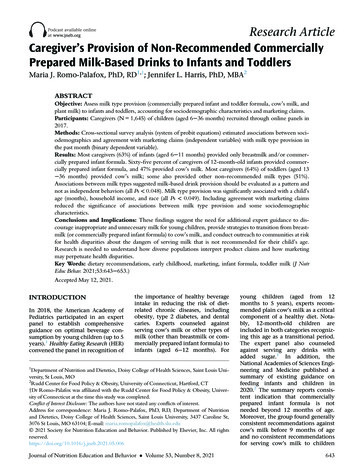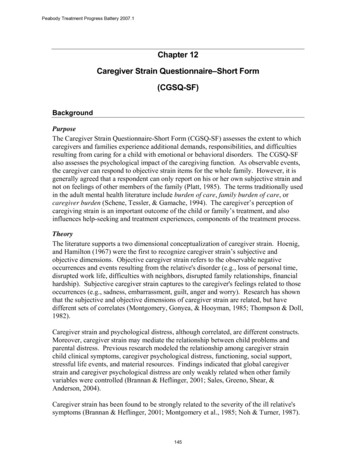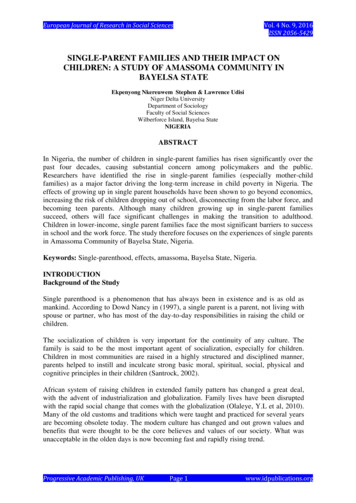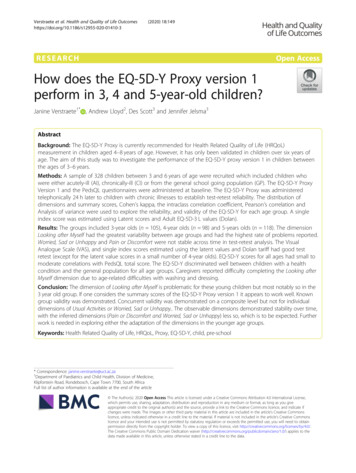
Transcription
Research ArticleCaregiver’s Provision of Non-Recommended CommerciallyPrepared Milk-Based Drinks to Infants and ToddlersMaria J. Romo-Palafox, PhD, RD1,y; Jennifer L. Harris, PhD, MBA2ABSTRACTObjective: Assess milk type provision (commercially prepared infant and toddler formula, cow’s milk, andplant milk) to infants and toddlers, accounting for sociodemographic characteristics and marketing claims.Participants: Caregivers (N 1,645) of children (aged 6 36 months) recruited through online panels in2017.Methods: Cross-sectional survey analysis (system of probit equations) estimated associations between sociodemographics and agreement with marketing claims (independent variables) with milk type provision inthe past month (binary dependent variable).Results: Most caregivers (63%) of infants (aged 6 11 months) provided only breastmilk and/or commercially prepared infant formula. Sixty-five percent of caregivers of 12-month-old infants provided commercially prepared infant formula, and 47% provided cow’s milk. Most caregivers (64%) of toddlers (aged 13 36 months) provided cow’s milk; some also provided other non-recommended milk types (51%).Associations between milk types suggested milk-based drink provision should be evaluated as a pattern andnot as independent behaviors (all Ps 0.048). Milk type provision was significantly associated with a child’sage (months), household income, and race (all Ps 0.049). Including agreement with marketing claimsreduced the significance of associations between milk type provision and some sociodemographiccharacteristics.Conclusions and Implications: These findings suggest the need for additional expert guidance to discourage inappropriate and unnecessary milk for young children, provide strategies to transition from breastmilk (or commercially prepared infant formula) to cow’s milk, and conduct outreach to communities at riskfor health disparities about the dangers of serving milk that is not recommended for their child’s age.Research is needed to understand how diverse populations interpret product claims and how marketingmay perpetuate health disparities.Key Words: dietary recommendations, early childhood, marketing, infant formula, toddler milk (J NutrEduc Behav. 2021;53:643 653.)Accepted May 12, 2021.INTRODUCTIONIn 2018, the American Academy ofPediatrics participated in an expertpanel to establish comprehensiveguidance on optimal beverage consumption by young children (up to 5years).1 Healthy Eating Research (HER)convened the panel in recognition ofthe importance of healthy beverageintake in reducing the risk of dietrelated chronic diseases, includingobesity, type 2 diabetes, and dentalcaries. Experts counseled againstserving cow’s milk or other types ofmilk (other than breastmilk or commercially prepared infant formula) toinfants (aged 6 12 months). For1Department of Nutrition and Dietetics, Doisy College of Health Sciences, Saint Louis University, St Louis, MO2Rudd Center for Food Policy & Obesity, University of Connecticut, Hartford, CTyDr Romo-Palafox was affiliated with the Rudd Center for Food Policy & Obesity, University of Connecticut at the time this study was completed.Conflict of Interest Disclosure: The authors have not stated any conflicts of interest.Address for correspondence: Maria J. Romo-Palafox, PhD, RD, Department of Nutritionand Dietetics, Doisy College of Health Sciences, Saint Louis University, 3437 Caroline St,3076 St Louis, MO 63104; E-mail: maria.romopalafox@health.slu.eduÓ 2021 Society for Nutrition Education and Behavior. Published by Elsevier, Inc. All .05.006Journal of Nutrition Education and Behavior Volume 53, Number 8, 2021young children (aged from 12months to 5 years), experts recommended plain cow’s milk as a criticalcomponent of a healthy diet. Notably, 12-month-old children areincluded in both categories recognizing this age as a transitional period.The expert panel also counseledagainst serving any drinks withadded sugar.1 In addition, theNational Academies of Sciences Engineering and Medicine published asummary of existing guidance onfeeding infants and children in2020.2 The summary reports consistent indication that commerciallyprepared infant formula is notneeded beyond 12 months of age.Moreover, the group found generallyconsistent recommendations againstcow’s milk before 9 months of ageand no consistent recommendationsfor serving cow’s milk to children643
644Romo-Palafox and Harrisaged 9 12 months. The findings alsoinclude consistent recommendationsagainst sugar-sweetened beveragesand plant milk from birth to 24months of age.2Theserecommendationsalsoreflect the growing popularity ofalternative milk and potential issueswith serving them to young children.The HER panel established guidancefor alternative milk for young children, recommending against providing toddler milk because of theiradded sugar content and higher costthan cow’s milk. Toddler milk products (toddler formula or growing-upmilk) are typically powdered milkbased products offered by commercially prepared infant formula manufacturers and marketed as beneficialfor toddlers (aged 1 3 years).3,4 Toddler milk represent the fastest-growing formula category in the US, withsales increasing 2.6 times from 2006to 2015.5 During this time, manufacturers also increased their advertisingexpenditures 4-fold,6 with marketingclaims that imply considerable benefits for toddlers’ development andpromote them as superior to cow’smilk. Research in the US and othercountries suggests considerable consumer confusion about the differencebetween commercially preparedinfant formula and toddler milk.3,7,8One study reported that approximately 40% of toddler caregiversadmitted serving a toddler milk totheir child, and 11% of infant caregivers selected a toddler milk as thecommercially prepared formula theyserved most often.9Other experts raise concerns aboutunproven and potentially misleadingclaims on toddler milk and infantPreviousresearchformula.9,10showed that the majority of caregivers of infants incorrectly believedthat commercially prepared infantformula can be better for babies’digestion and brain developmentthan breastmilk and that it can provide nutrition not present in breastmilk (52% and 62%, respectively),promises that are commonly impliedin marketing for these products.9Similarly, 60% of toddlers’ caregiversmisperceived that toddler milk provide nutrition to toddlers thatthey do not get from other foods.9 Inthat study, agreement with theseJournal of Nutrition Education and Behavior Volume 53, Number 8, 2021marketing claims increased the oddsof serving commercially preparedinfant formula and/or toddler milkto infants and toddlers.9The HER expert panel also advisedthat a plant milk (eg, rice, nuts, oatmilk) should not replace cow’s milkunless medically indicated to meetspecific dietary preferences (eg, vegandiets).1 The National Academiesreport also included consistent recommendations against plant milkfrom birth to 24 months of age.2However, sales of plant milk havealso grown rapidly in the US, increasing by 61% from 2012 to 2017.11Most plant milk are not consideredan adequate substitute for cow’s milkbecause of a lack of evidence thatadded nutrients in these products arecomparable to those that occur naturally in cow’s milk and often containadded sugars.12 14 Nutrient deficiencies have been reported on infantsfed exclusively with plant-basedmilk, including rickets, kwashiorkor,and metabolic alkalosis.15 One studyfound that 4.5% of young children(aged 2 4 years) consumed plantmilk on a given day, but research hasnot assessed consumption by children aged 2 years.16,17The objective of this study wasto assess the prevalence of servingnon-recommended milk beverages(ie, toddler milk and plant milk)in place of and in addition to recommended milk-based products(including commercially preparedinfant formula and cow’s milk) forinfants (aged 6 11 months) andtoddlers (aged 13 36 months). Theauthors examined 12-month-oldchildren separately to account forthe inclusion of this age group inboth infant and toddler guidanceon serving commercially preparedinfant formula and cow’s milk. Italso examined differences in milkprovision patterns by householdincome and caregiver race/ethnicity,as well as participants’ agreementwith marketing claims.METHODSThis study used a cross-sectionalonline survey of US primary caregivers of infants (aged 6 11 months),infants in transition (aged 12months), and toddlers (aged 13 36months). The large nonprobabilitysample (n 1,645) included a diversesample of participants for meaningful comparisons between demographic groups. This analysis reportsthe incidence of caregivers’ provisionof commercially prepared infant formula, toddler milk, cow’s milk, andplant milk in the past month. Thesurvey also assessed other feedingpractices, attitudes about products,and marketing claims.9Survey ParticipantsParticipants were recruited through anational online survey panel (Innovate, Calabasas, CA) and anotherpanel of Hispanic households (Offerwise, Ashburn, VA). Both panels provide members with nonmonetaryincentives for voluntary survey participation. Members receive pointsfor completing surveys and redeemthem for incentives, such as onlinegift cards and charitable donations.The panel companies invited caregivers with at least one 6 36-monthold child to participate in this survey.A random sample of 600 participantswas requested with augments toobtain minimum numbers of Blacknon-Hispanic (n 400), Asian PacificIslander (n 180), and Hispanic(n 600; English- and Spanish-speaking) participants. Quota samplingensured approximately equal numbers of respondents by child’s agegroup (6 11, 12 23, and 24 36months) and household incomegroup ( 15,000 39,999, 40,000 74,999, and 75,000). This recruiting plan allowed for meaningfulcomparisons between groups ofinterest.18 Panel members whoagreed to participate received a linkto the 30-minute online survey (participants could choose English orSpanish) delivered via Qualtrics software (version 2016, Qualtrics, 2016).Data collection occurred from Aprilto June, 2017. The University of Connecticut’s Institutional Review Boardapproved all measures and procedures.Survey Measures and DesignSurvey items were pretested usinga convenience sample of 20 caregivers of young children (aged 6 36
Journal of Nutrition Education and Behavior Volume 53, Number 8, 2021months). In 1-on-1 cognitive interviews, researchers tested the surveyadministration process and askedcaregivers to think out loud while responding to each survey questionand then answer probes to identifyany comprehension, interpretation,or recall issues.19,20Selection of child. Participants werescreened for children living in theirhouseholds aged between 6 and 36months and responsibility regardingfeeding decisions. Children with adisease or condition that requires aspecial diet (eg, lactose intolerance)were excluded (n 233). Participantswith more than 1 eligible childselected the child with the mostrecent birthday.Patterns of milk type provision. Participants answered whether they hadever breastfed their child and atwhat age they stopped breastfeeding.They then selected all types of milkthey served their child in the pastmonth, including commercially prepared infant formulas, other formulas or powdered milk, regular milk(ie, cow’s milk), nondairy milk (eg,almond, coconut, and soy), other(fill-in), and none of the above(including exclusive breastfeeding).To address potential confusion aboutthe difference between commerciallyprepared infant formula and toddlermilk,6 the survey provided multipleexamples of brand names (eg, Enfamil, Enfagrow, and Similac Go &Grow) and did not use the term toddler milk.Frequency of serving milk types. Participants then reported the frequencythey provided regular milk and/ornondairy milk using a 6-item frequency scale (from once in the pastmonth to more than once per day). Ifparticipants reported providing commercially prepared infant formulaand/or other formulas or toddlermilk in the past month, they firstidentified the specific product theyserved most often (from package images and names of products fromall brands provided). They thenanswered the frequency they provided the product served most often.This process accounted for potentialconfusion between commerciallyprepared infant formula and toddlermilk.Agreement with expert recommendationsand marketing claims. Participantsselected their agreement with variousstatements and claims about commercially prepared infant formulas,toddler milk, and other drinks foreither infants or toddlers (7-pointLikert scale from strongly disagree tostrongly agree).Caregivers of infants rated theiragreement with 4 marketing claimscommonly found on regular infantformula packages: (1) infant formulascan provide nutrition that babies donot get from breastmilk; (2) infantformulas can be better for babies’digestion than breastmilk; (3) infantformulas can be better for babies’brain development than breastmilk,and (4) infant formulas help babiesgrow.1,3 5,9 Toddler caregivers saw 1toddler milk product claim (adaptedfrom common claims on toddlermilk): toddler formulas or powderedmilk provide nutrition that toddlersdo not get from other food anddrinks.1,3 5,9 Because of high covariance between the 4 infant formulamarketing claims (a 0.81), researchers averaged them to create a scalefor agreement with infant formulaclaims. Researchers categorized responses to the commercially prepared informant formula claims scaleand the toddler milk claim as agree( 5) or neutral/disagree ( 5).Caregiver demographics. Finally, participants reported demographicinformation including householdincome, race, and ethnicity, whichwas self-reported by the parents ofthe children from a list includingnon-Hispanic White, non-HispanicBlack, Hispanic, Asian or PacificIslander, Native American (including Alaskan), biracial or multiracial(specify), or other (please specify).Participants selecting Hispanic ethnicity also answered the ShortAcculturation Scale for Hispanicsto assess language preference, ranging from 1 (only Spanish) to 5(only English). In accordance withShort Acculturation Scale for Hispanics methodology, participantsscoring 3.0 were classified asless acculturated.21,22Romo-Palafox and Harris645Statistical AnalysisThe data analyses for this paper weregenerated using SAS (version 9.4, SASInstitute Inc, 2013). Descriptive statistics include incidence and frequencyof provision of milk type and combinations of milk types served. Model 1:a system of probit equations estimatedthe regression coefficients for provision of each milk type (binary outcome variables) and child age (inmonths), household income, andrace/ethnicity as predictors, with separate models for infants (aged 6 11months) and toddlers (aged 13 36months); 12-month-old children wereexcluded from these analyses. As foodchoices cannot be assumed to be independent, this method accounts for thepossibility that some predictor variables (eg, child age in months, household income, and race/ethnicity) arejointly determined with the outcomevariables (binary variables of the provision of each milk type) and allows forcorrelation of error components acrossequations for each type of milk.23 Inaddition, the regression coefficientswere used to estimate the predictedprobability of serving each milk typeby child’s age and household demographics, accounting for other milktypes served to infants (SupplementaryTable 1) and toddlers (SupplementaryTable 2). Model 2: included the samesystem of probit models as model 1with the addition of a binary dummyvariable indicating agreement withmarketing claims. Post hoc power analysis from a general linear model usingSAS with milk types as dependent andsociodemographic characteristics asindependent variables, at alpha 0.05and n 1,607 showed that all comparisons were well powered ( 0.8), withthe exception of nondairy milk provision by race (power 0.22).RESULTSThe sample participants (N 1,645)were mostly female, aged 25 44 years,married, with at least some collegeeducation, and approximately halfhad household incomes 40,000(Table 1). Because of sampling procedures, participants were diverse inrace/ethnicity. Of the original 2,426participants, 13% did not meet inclusion criteria, and 14% did not
646Journal of Nutrition Education and Behavior Volume 53, Number 8, 2021Romo-Palafox and HarrisTable 1. Sociodemographic Characteristics of Caregivers of Children Aged 6 36 Months (n 1,645) (2017)Age of ChildInfants,6 11 moCharacteristicsaSampleCaregiver race/ethnicityWhite non-HispanicBlack non-HispanicHispanic: more acculturated23Hispanic: less acculturatedAsianMixed/otherHousehold incomeb 40,000 40,000 74,000 75,000Caregiver genderFemalebMaleCaregiver educationHigh school or GEDSome college or 2-y collegeCollege graduate or higherCaregiver age, y18 2425 3435 44 45Marital statusSingleMarriedChild genderFemaleMaleInfants in Transition,12 moYoung Toddlers,13 23 moOlder Toddlers24 36 422342674753262272495181083549511,645 100aCaregivers of children aged 6 36 months, who had responsibility for feeding their child without dietary restrictions recruited viaonline panels; bDoes not total 100% because of missing data.complete the survey for a completionrate of 72%. Data for an additional 107participants were excluded because ofinconsistent responses.Patterns of Milk Type ProvisionApproximately two-thirds of caregiversreported serving the types of milk thatexperts recommend for their infant ortoddler (Table 2), including breastfeeding and/or serving commerciallyprepared infant formula with noother milk type to infants and servingcow’s milk to toddlers in the pastmonth. Approximately two thirds ofcaregivers for infants in transition(aged 12 months) provided any commercially prepared infant formula,approximately a quarter providedcommercially prepared infant formulawith cow’s milk, and 15% providedcow’s milk only.However, more than one third ofinfant caregivers surveyed reportedserving at least 1 non-recommendedmilk type to their infant in the pastmonth, including toddler milk and/orcow’s milk, and most reported providing them daily (Table 3). Furthermore,the majority of toddler caregivers didnot follow expert recommendations toprovide only cow’s milk to their children in the past month. Of the nonrecommended milk types, toddlercaregivers reported serving commercially prepared infant formula mostoften, followed by toddler milk andplant milk. Approximately one-half ofthose who served commerciallyprepared toddler milk or infant formula to their toddler reported servingit daily. For both age groups, caregiverstended to provide non-recommendedmilk types in addition to recommended types, including commercially prepared infant formula forinfants and plain cow’s milk for toddlers.Associations of Child andHousehold Demographics Withthe Type of Milk ProvidedProvision of milk types. The models topredict the provision of differentmilk types to infants (aged 6 11months) (Table 4) and toddlers (aged13 36months)(Table5)
Journal of Nutrition Education and Behavior Volume 53, Number 8, 2021Romo-Palafox and Harris647Table 2. Patterns of Milk Type Provision to Infants Aged 6 11 Months (n 544) and Toddlers Aged 13 36 Months(n 1,008) (2017) aWith or Without Cow’s MilkMilk TypeInfants aged 6 11 mo, n 544Ever breastfedRecommended milk onlyExclusive breastfeedingCommercially prepared infant formula (including breastmilksupplementation)Total recommended onlyNot recommended milkAny toddler milkAny cow’s milkPlant milkTotal not recommendedCombinations of milk servedCommercially prepared infant formula and toddler milkCommercially prepared infant formula and cow’s milkCommercially prepared infant formula, cow’s milk, and toddler 818185With Cow’s MilkMilk TypeInfants in transition aged 12 months, n 55Any cow’s milkOnly cow’s milkCow’s milk with other milk typesNo milk (any type)Combinations of milk servedAny toddler milkAny commercially prepared infant formulaAny plant milkCommercially prepared infant formula and toddler milkYounger toddlers aged 13 23 mo, n 490Any cow’s milkOnly cow’s milk (recommended)Cow’s milk with other milk typesNo milk (any type)Combinations of milk servedAny toddler milkAny commercially prepared infant formulaAny plant milkCommercially prepared infant formula and toddlerOlder toddlers aged 24 36 mo, n 518Any cow’s milkOnly cow’s milk (recommended)Cow’s milk with other milk typesNo milk (any type)Combinations of milk servedAny toddler milkAny commercially prepared infant formulaAny plant milkCommercially prepared infant formula and toddler 1No Cow’s Milkn%No Cow’s 10aCaregivers of children aged 6 36 months who had responsibility for feeding their child without dietary restrictions recruited viaonline panels.
648Romo-Palafox and HarrisJournal of Nutrition Education and Behavior Volume 53, Number 8, 2021Table 3. Frequency of Milk Type Provision to Infants Aged 6 11 Months (n 544) and Toddlers Aged 13 36 Months(n 1,008) (2017) aMilk TypeCommercially prepared infant formulabMonthlyWeeklyDailyToddler milkbMonthlyWeeklyDailyCow’s milkMonthlyWeeklyDailyPlant milkMonthlyWeeklyDailyInfants,6 11 moInfants in Transition,12 moYoung Toddlers,13 23 moOlder Toddlers,24 36 mon 32852471n 54112069n 10992863n 39153351n 29171072n 9332244n 26231958n 650500n 213252254n 115173054n 31091972n 93333829n 182292447n 110262351n 31472271n 101164837aCaregivers of children 6 36 months of age, who had responsibility for feeding their child without dietary restrictions recruitedvia online panels; bProduct served most often.Note: Values are %.demonstrated relationships betweenthe provision of some types. For infants, provision of commercially prepared infant formula was associatedwith an increased probability ofproviding cow’s milk (P 0.003)but not toddler milk or plant milk,whereas providing toddler milk (P 0.001) and/or cow’s milk (P 0.001) predicted also serving plantmilk. For toddlers, providing cow’smilk was positively related to providing plant milk (P 0.02) butnegatively associated with providing toddler milk (P 0.001) andcommercially prepared infant formula (P 0.001). Providing toddlermilk was also related to anincreased probability of providingplant milk (P 0.02).Child’s age. Predicted probabilities inmodel 1, before inclusion of agreement with marketing claims (Table 4)show that, after controlling for associations between types of milkserved, child’s age (in months)increased the probability of servingcow’s milk to infants (P 0.04) anddecreased the probability of servingcommercially prepared infant formula to toddlers (P 0.001). However, age was not related to theprovision of other milk types. Inaddition, after controlling forassociations between types of milk,child’s age in months, annualincome, and racial or ethnic background in model 2 agreement withmarketing claims increased the probability of serving all milk types to infants and toddler milk and cow’smilk to toddlers.Household income. Household income was also related to the types ofmilk provided to infants. In model 1,caregivers from middle- and lowerincome households were more likelyto provide commercially preparedinfant formula than caregivers inhigher-income households (P 0.03and P 0.01, respectively). In addition, caregivers in middle-incomehouseholds were more likely to provide toddler milk than caregivers inlower-income households (P 0.03).Infant caregivers in the middleincome group were more likely toprovide plant milk than caregiversfrom higher-income households(P 0.02) and lower-income households (P 0.001). With the additionof the marketing claim variable inmodel 2, all relationships betweenhousehold income and milk typeprovisionremainedsignificantexcept for that between income andtoddler milk provision (P 0.056). Fortoddlers, higher-income householdswere less likely to provide cow’smilk (P 0.001 for lower- and middleincome households) while more likelyto provide toddler milk (P 0.001 forlower- and middle-income households) and commercially preparedinfant formula (P 0.001 comparedwith lower-income households).Plant milk provision was also associated with household income,with caregivers from middle- andhigher-income households morelikely to provide plant milk thanthose in lower-income households (P 0.001). These significantrelationships remained after theaddition of the marketing claimvariable in model 2.Racial and ethnic background: Infantcaregivers. There were some differences in milk type provision by race/ethnicity for infant caregivers(Table 4) (model 1). Compared withnon-HispanicWhitecaregivers,Asian caregivers were more likely toprovidecommerciallypreparedinfant formula (P 0.01) and cow’smilk (P 0.001), and Hispanic caregivers (less acculturated [P 0.003]and more acculturated [P 0.02])were less likely to provide cow’s milk.Post hoc comparisons with Bonferroniadjustments (Supplementary Table)showed that Asian (P 0.001) and
Model 1: Milk Type Provision and SociodemographicsCommerciallyPreparedInfant FormulaIndependent VariableBetaCIProvision of milk typesCommercially preparedinfant formulaToddler milk0.15 0.03 to 0.33Cow’s milk0.29 0.10 to 0.48Plant milk0.18 0.07 to 0.42a0.00 0.07 to 0.08Child age, moHousehold Income 75,000 (comparisongroup) 40,000 to 74,9990.43 0.12 to 0.75 39,9990.34 0.04 to 0.65Racial or ethnic backgroundWhite non-Hispanic(comparison group)Black non-Hispanic0.22 0.08 to 0.53Hispanic: less acculturated 0.26 0.64 to 0.11Hispanic: more acculturated 0.14 0.53 to 0.25Asian0.59 0.14 to 1.04Marketing claimsNeutral or disagree(comparison group)AgreeToddler MilkP0.110.0030.150.94BetaCIModel 2: Milk Type Provision, Sociodemographics, and Agreement With Marketing ClaimsCow’s MilkP0.17 0.00 to 0.330.0470.47 0.29 to 0.65 0.0010.05 0.03 to 0.130.200.010.030.13 0.31 to 0.31 0.19 0.51 to 0.130.400.240.150.170.480.010.28 0.36 0.23 0.08 0.02 to 0.58 0.82 to 0.09 0.68 to 0.22 0.49 to 0.340.070.120.310.72Beta0.490.09CI0.30 to 0.670.00 to 0.170.30 0.04 to 0.630.03 0.31 to 0.38CommerciallyPreparedInfant FormulaPlant MilkP 0.0010.040.080.85BetaCIP0.06 0.05 to 0.16 0.290.53 0.09 to 0.96 0.02 0.27 0.74 to 0.20 0.260.29 0.02 to 0.600.07 0.43 0.85 to 0.00 1.12 1.87 to 0.370.004 0.16 0.75 to 0.43 0.72 1.32 to 0.130.02 0.26 0.90 to 0.380.77 0.38 to 1.16 0.001 0.07 0.46 to 0.60BetaCIToddler MilkP0.11 0.07 to 0.30 0.220.27 0.08 to 0.46 0.0060.16 0.10 to 0.43 0.230.00 0.07 to 0.07 0.990.440.390.12 to 0.76 0.010.08 to 0.71 0.010.05 0.07 0.27 to 0.400.59 0.26 0.64 to 0.120.42 0.13 0.52 to 0.260.80 0.42 0.06 to 0.890.35BetaCICow’s MilkP0.16 0.01 to 0.320.070.50 0.29 to 0.70 0.0010.05 0.03 to 0.120.24Beta0.460.08Plant MilkCIP0.27 to 0.650.00 to 0.17 0.0010.05BetaCIP0.06 0.05 to 0.170.300.15 0.17 to 0.46 0.15 0.47 to 0.170.360.370.31 0.02 to 0.650.06 0.28 to 0.410.070.720.56 0.10 to 1.02 0.27 0.77 to 0.240.020.30 0.63 0.20 0.27 0.12 1.12 to 0.15 0.84 to 0.45 0.95 to 0.42 0.69 to 0.460.010.540.440.690.00 to 0.820.050.700.180.520.090.12 0.35 0.21 0.25 0.20 to 0.45 0.80 to 0.11 0.66 to 0.24 0.69 to 0.190.460.140.370.260.16 0.18 to 0.50 1.11 1.87 to 0.35 0.70 1.30 to 0.100.63 0.22 to 1.040.350.0040.020.0030.08 to 0.63 0.010.370.09 to 0.660.010.30 0.01 to 0.610.060.41Romo-Palafox and HarrisCI indicates confidence interval.aMonths of age included as a continuous variable in the model, beta refers to the change per additional month of age.Note: Results from the system of simultaneous probit models with provision of milk type (binary outcome variables) and demographic differences as predictors for a sample ofcaregivers of children aged 6 to 36 months, who had responsibility for feeding their child without dietary restrictions recruited via online panels. Beta coefficients and CI are reported; significance was set at P 0.05. Post hoc power analysis showed that plant milk comparisons by race were underpowered; therefore, caution when interpreting thesefindings is warranted.Journal of Nutrition Education and Behavior Volume 53, Number 8, 2021Table 4. Associations of Child and Household Demographics With Type of Milk Provided to Infants Aged 6 11 Months (n 544) (2017)649
650Romo-Palafox and HarrisTable 5. Associations of Child and Household Demographics With Type of Milk Provided to Toddlers Aged 13 36 Months (n 1,008) (2017)Model 1: Milk Type Provision and SociodemographicsCow’s MilkIndependent VariableBetaCIToddler MilkPBetaCI 0.16 0.25 to 0.06 0.001 0.38 0.47 to 0.28 0.001 0.03 0.14 to 0.070.14 0.03 to 0.240.00 0.01 to 0.010.470.400.25 to 0.690.20 to 0.61CommerciallyPrepared InfantFormula0.020.630.15 0.03 to 0.27 0.01 0.02 to 0.01PBetaCIPlant MilkPBetaCICow’s MilkPCIToddler MilkPBetaCI 0.18 0.28 to 0.08 0.001 0.41 0.50 to 0.31 0.001 0.05 0.15 to 0.050.5360.020.37Beta 0.05 0.16 to 0.060.34 0.03 0.04 to 0.02 0.001 0.001 0.62 0.83 to 0.40 0.001 0.17 0.39 to 0.05 0.001 0.76 0.96 to 0.55 0.001 0.36 0.57 to 0.150.00 0.01 to 0.020.610.13 0.13 0.36 to 0.10 0.260.001 0.55 0.78 to 0.32 .0010.15 0.03
1Department of Nutrition and Dietetics, Doisy College of Health Sciences, Saint Louis Uni-versity, St Louis, MO 2Rudd Center for Food Policy & Obesity, Universityof Connecticut, Hartford, CT yDr Romo-Palafox was affiliated with the Rudd Center for Food Policy & Obesity, Univer-sityof Connecticut at the time this study was completed.











